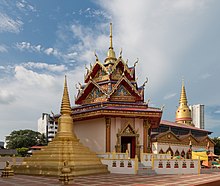วัดไชยมังคลาราม
| วัดไชยมังคลาราม | |
|---|---|
 | |
| ศาสนา | |
| ศาสนา | พุทธ |
| เขต | เกาะปีนังตะวันออกเฉียงเหนือ |
| ที่ตั้ง | |
| ที่ตั้ง | ปูเลาตีกุซ |
| รัฐ | ปีนัง |
| ประเทศ | มาเลเซีย |
| พิกัดภูมิศาสตร์ | 5°25′54.479″N 100°18′48.276″E / 5.43179972°N 100.31341000°E |
| สถาปัตยกรรม | |
| ประเภท | ไทย |
| ผู้ก่อตั้ง | พ่อท่านขวด[1][2] |
| เริ่มก่อตั้ง | ค.ศ. 1845[1][2][3] |
วัดไชยมังคลาราม มีชื่อเดิมว่า วัดปูเลาตีกุซ หรือ วัดโหละติโกย[4] เป็นวัดไทยแห่งหนึ่งบนถนนเกอลาไว ตำบลปูเลาตีกุซในเมืองจอร์จทาวน์ รัฐปีนัง ประเทศมาเลเซีย ตั้งอยู่ตรงกันข้ามกับวัดพม่าธรรมิการาม ซึ่งเป็นวัดพม่าที่มีชื่อเสียงของรัฐปีนัง[5] ถือเป็นศาสนสถานของชาวสยามที่เก่าแก่ที่สุดในเกาะปีนัง โดยวัดนี้มีความโดดเด่นจากการจัดงานประเพณีอย่างไทย เช่น สงกรานต์และลอยกระทง รวมทั้งมีการเดินขบวนแห่แหนตามท้องถนนในวันวิสาขบูชาในทุกปี[6][7]
วัดไชยมังคลารามเป็นวัดไทยที่มีชื่อเสียงบนเกาะปีนัง ภายในอุโบสถมีพระนอนยาวที่สุดในประเทศมาเลเซีย โดยมีความยาว 108 ฟุต สร้างเมื่อปี พ.ศ. 2500 โดยมีชื่อว่าพระพุทธชัยมงคล พระบาทสมเด็จพระปรมินทรมหาภูมิพลอดุลยเดชได้พระราชทานนามให้ในคราวเสด็จประพาสเมื่อวันที่ 25 มิถุนายน พ.ศ. 2505[8]
ประวัติ[แก้]
วัดไชยมังคลารามเป็นวัดเก่าแก่ สร้างในปี พ.ศ. 2388 สร้างโดยบริษัทอินเดียตะวันออก (East India Company) ซึ่งเป็นบริษัทการค้าของอังกฤษในนามของสมเด็จพระราชินีนาถวิกตอเรีย ศิลปะของวัดไชยมังคลารามนั้นเป็นการผสมผสานระหว่างศิลปะไทย พม่า และจีนเข้าด้วยกัน ซึ่งทำให้วัดแห่งนี้มีสีสันสะดุดตา ดูแปลกไปจากวัดในประเทศไทย ที่เน้นศิลปะที่อ่อนช้อย แต่ศิลปะของวัดแห่งนี้จะเป็นแบบเรียบ ไม่มีการแกะสลัก ทำลวดลายให้ดูวิจิตรมากนัก[9]
ทุกวันนี้บนเกาะปีนังก็มีคนไทยที่สืบเชื้อสายจากคนรุ่นก่อนอาศัยอยู่เป็นจำนวนหนึ่ง และประชากรส่วนใหญ่ในปีนังเป็นคนเชื้อสายจีนที่เข้ามาทำมาค้าขาย และนับถือศาสนาพุทธ ทำให้เกาะปีนังมีวัดไทยที่เป็นศูนย์รวมของชาวพุทธ มีกิจกรรมทางศาสนาในวันสำคัญ [10]
อ้างอิง[แก้]
- ↑ 1.0 1.1 Khoo Salma Nasution (2012). "Exploring Shared History, Preserving Shared Heritage: Penang's Links to a Siamese Past [The Siamese community and Buddhism in Penang]" (PDF). Journal of the Siam Society. Siamese Heritage. 100: 313 [10/15]. คลังข้อมูลเก่าเก็บจากแหล่งเดิม (PDF)เมื่อ 23 March 2019. สืบค้นเมื่อ 23 March 2019.
The site of the Pulau Tikus Siamese Temple, the oldest Siamese temple in Penang, was cleared in 1795 and a Burmese temple was established there since the early nineteenth century. Around 1830, the Siamese and Burmese community totalled 648 out of a population of about forty thousand. In 1845, during the term of W. J. Butterworth as governor of the Straits Settlements, the East India Company made a grant of land to the Burmese and Siamese inhabitants to be jointly held by Nongmay and Boonkhan as representatives of the Burmese community, and Nankayo and Boonsoon as representatives of the Siamese community. The first head priest was Phra Kuad. Inscriptions showed that the building of the temple had been largely due to the philanthropic efforts of Chinese Buddhists. This temple was renamed Wat Chaiya Mangkalaram in 1948, and its famous Reclining Buddha statue was unveiled by the Thai king and queen before a crowd of 5,000 during their official trip to Malaya in 1962.
- ↑ 2.0 2.1 "A Tale of Three Temples – The Temples of Pulau Tikus". Penang Free Sheet. คลังข้อมูลเก่าเก็บจากแหล่งเดิมเมื่อ 23 March 2019. สืบค้นเมื่อ 23 March 2019.
Across the street, closer than a stone's throw away, is the Wat Chayamangkalaram. Much like its Burmese neighbour, the temple is a feast of colours – particularly gold. Queen Victoria first granted the land to the Buddhist community in 1845 to promote trade between the British Empire and Siam. A thing of beauty, if not dominance, the reclining Buddha is the temple's centrepiece and main place of worship. However, as well as serving as a stunning backdrop for people praying and burning incense, it also serves as columbarium. A visitor can walk completely around the statue and, at the back of the statue, can view where the urns of the cremated are housed. One thing to notice when visiting the temple is the offerings made at different shrines. Of note, you can sometimes find a bowl of laksa sitting at the base of a shrine. It is not unusual for offerings of food to appear at Buddhist places of worship, but laksa supposedly has a specific relevance. The first monk in Wat Chaiyamangkalaram was Phorthan Kuat, a Theravada Buddhist monk from Siam also known as the 'Powerful Monk'. It is said that he was very fond of asam laksa and, to this day, the famous local dish is still offered to his shrine by devotees.
- ↑ "Buddhist temples in Penang". New Straits Times. 24 May 2018. สืบค้นเมื่อ 24 March 2019 – โดยทาง PressReader.
- ↑ พิเชฐ แสงทอง (พฤษภาคม-สิงหาคม 2560). "ศึกไทย-พม่าที่ปีนัง: แกะรอยปริศนาปีสร้างและคดีความที่วัดปูเลาติกุส (ไชยมังคลาราม) มาเลเซีย". วารสารรูสมิแล. สืบค้นเมื่อ 22 มิถุนายน 2562.
{{cite web}}: ตรวจสอบค่าวันที่ใน:|accessdate=(help) - ↑ Joshua Eliot; Jane Bickersteth (2002). Malaysia Handbook: The Travel Guide. Footprint Handbooks. p. 160. ISBN 978-1-903471-27-2.
- ↑ Arnold Loh (14 April 2015). "Water Festival celebrations off to a soaking start at Burmese Buddhist temples". The Star. สืบค้นเมื่อ 23 March 2019.
Revellers at the Water Festival "fired" at visitors with their water guns at the Wat Chayamangkalaram and Dhammakirama Burmese Buddhist temples in Burma Lane, where the three day celebrations began yesterday.
- ↑ "Five million Malaysians celebrate Songkran and Good Friday". The Sun. 13 April 2017. สืบค้นเมื่อ 23 March 2019.
Hundreds of revellers thronged Wat Chayamangkalaram in Pulau Tikus here to usher in the Thai New Year or more popularly known as Songkran.
- ↑ "สำเนาที่เก็บถาวร". คลังข้อมูลเก่าเก็บจากแหล่งเดิมเมื่อ 2009-03-10. สืบค้นเมื่อ 2009-08-27.
- ↑ "สำเนาที่เก็บถาวร". คลังข้อมูลเก่าเก็บจากแหล่งเดิมเมื่อ 2010-01-02. สืบค้นเมื่อ 2009-08-27.
- ↑ "สำเนาที่เก็บถาวร". คลังข้อมูลเก่าเก็บจากแหล่งเดิมเมื่อ 2009-04-13. สืบค้นเมื่อ 2009-08-27.

